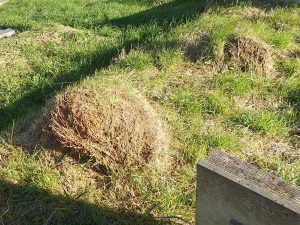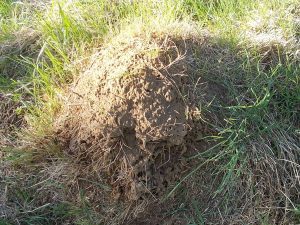Ant-hills
Now that the grass has been cut in the conservation area of the cemetery it looks very different, and we can see many things that were previously hidden from view.
Very noticeable are the great amount of ant-hills dotted about, most of which are quite large. Several of the headstones are completely covered. Another reaches right up to the top plinth of a 3 tier plinth memorial.
One of those pictured here, clings to the footstone of a memorial.


Ant-Hills and Ant Colonies
An ant-hill, in its simplest form, is a pile of earth, sand, pine needles, or clay, or a composite of these and other materials that build up at the entrances of the subterranean dwellings of ant colonies as they are excavated. A colony is built and maintained by legions of worker ants, who carry tiny bits of dirt and pebbles in their mandibles and deposit them near the exit of the colony. They normally deposit the dirt or vegetation at the top of the hill to prevent it from sliding back into the colony.
An ant colony, also called a formicary, is the basic family unit around which ants organise their lifecycle. The typical colony consists of one or more egg-laying queens, a large number of sterile females (workers) and, seasonally, a large number of winged sexual males and females, who depart the nest in great nuptial flights. The males die shortly thereafter, along with most of the females. A small percentage of females survive to initiate new nests.
Source: Ant-hills and Ant Colonies – Wikipedia
Photographs by David Bushell

